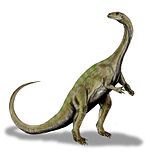Forest Sandstone
Geologic formation in Southern Africa From Wikipedia, the free encyclopedia
Geologic formation in Southern Africa From Wikipedia, the free encyclopedia
The Forest Sandstone is a geological formation in southern Africa, dating to roughly between 200 and 190 million years ago and covering the Hettangian to Sinemurian stages of the Jurassic Period in the Mesozoic Era.[1] As its name suggests, it consists mainly of sandstone.
| Forest Sandstone | |
|---|---|
| Stratigraphic range: Hettangian-Sinemurian ~ | |
 | |
| Type | Geological formation |
| Unit of | Karoo Supergroup Upper Karoo Group |
| Underlies | Batoka Formation |
| Overlies | Pebbly Arkose Formation |
| Lithology | |
| Primary | Sandstone |
| Location | |
| Coordinates | 20.0°S 28.4°E |
| Approximate paleocoordinates | 35.0°S 5.1°E |
| Region | South-central Africa |
| Country | |
| Type section | |
| Named for | Forests of Nyamandlovu District, Zimbabwe |
| Named by | A.M. MacGregor, Zimbabwe Geological Survey |
Fossils of the prosauropod dinosaur Massospondylus and the primitive sauropod Vulcanodon have been recovered from the Forest Sandstone.
The formation is a sedimentary unit, consisting mainly of aeolian sands and silts with interbedded fluvial sediments,[2] laid down during a period of increasing aridity.[3]
The Forest Sandstone is found in Botswana, Zambia and Zimbabwe, in the Mid-Zambezi, Mana Pools, Cabora Bassa and Limpopo Basins,[4][5][6][7] with its greatest thickness in the Cabora Bassa Basin.[8]
The Forest Sandstone is the penultimate formation in the Upper Karoo Group of the Karoo Supergroup, lying above the Pebbly Arkose Formation and below the Batoka Formation.[7] In the Thuli Basin it is sometimes referred to as the Samkoto Formation.[9]
The Forest Sandstone has been correlated to the Clarens Formation of the Great Karoo Basin in South Africa.[5][7][8]
| Protosuchia | ||||
|---|---|---|---|---|
| Genus | Species | Presence | Notes | Images |
|
indeterminate | Geographically located in Matabeleland North, Zimbabwe. | ||
| Sphenodontia of the Forest Sandstone Formation | ||||
|---|---|---|---|---|
| Genus | Species | Presence | Notes | Images |
|
indeterminate | Unspecified, Zimbabwe | ||
| Sauropodomorphs of the Forest Sandstone Formation | ||||
|---|---|---|---|---|
| Genus | Species | Presence | Notes | Images |
|
Geographically located in Matabeleland North, Zimbabwe.[11] |  | ||
|
Geographically located in the Bumi Hills area and the Sibilobilo Islands, in Kariba (District), Mashonaland West, Zimbabwe | Partial skeleton and scapula | ||
|
Geographically located in Matabeleland North, Zimbabwe.[11] | |||
| Theropods of the Forest Sandstone Formation | ||||
|---|---|---|---|---|
| Genus | Species | Presence | Notes | Images |
|
Geographically located in Nyamandhlovu area, Tsholotsho District, Matabeleland North, Zimbabwe.[11] | Note: Referred to as Syntarsus by Weishampel et al.[11] |  | |
The Forest Sandstone is the major groundwater-bearing unit of the Upper Karoo Group.[14]
Seamless Wikipedia browsing. On steroids.
Every time you click a link to Wikipedia, Wiktionary or Wikiquote in your browser's search results, it will show the modern Wikiwand interface.
Wikiwand extension is a five stars, simple, with minimum permission required to keep your browsing private, safe and transparent.